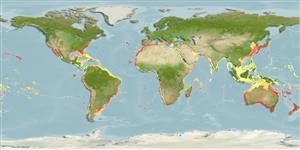Common names from other countries
分類 / Names
俗名 | 同種異名 | Catalog of Fishes(屬, 種) | ITIS | CoL | WoRMS | Cloffa
Teleostei >
Carangiformes (Jacks)
鱸形目 (Jacks) >
Carangidae (Jacks and pompanos)
鰺科 (Jacks and pompanos) > Caranginae
Etymology: Pseudocaranx: Greek, pseudes = false + French, carangue, the name of a Caribbean fish; 1836 (Ref. 45335).
More on authors: Bloch & Schneider.
Issue
The species Pseudocaranx cheilio (Snyder, 1904) is considered as valid in Eschmeyer (CofF ver. Mar. 2011: Ref. 86697) following Randall (2007: Ref. 86689). The species Pseudocaranx georgianus (Cuvier, 1833) is considered as valid in CofF ver. May. 2011 following Smith-Vaniz & Jelks (2006: Ref. 76781), with Caranx luna Geoffroy Saint-Hilaire, 1817, Caranx platessa Cuvier, 1833, Caranx nobilis Macleay,1881, and Usacaranx archeyi Griffin, 1932 as synonyms. Caranx georgianus (now under Pseudocaranx is also a valid species.
Environment: milieu / climate zone / depth range / distribution range
生態學
海洋; 半鹹淡水 礁區魚類; 深度上下限 10 - 238 m (Ref. 58302), usually 10 - 25 m (Ref. 5288). 熱帶; 40°N - 47°S
Western Atlantic: North Carolina, USA and Bermuda to southern Brazil. Eastern Atlantic: Mediterranean, Azores, Madeira, the Canary Islands, Cape Verde, Ascension and St. Helena Island. Indo-Pacific: South Africa, Japan, Hawaii (Ref. 26145), Australia, Lord Howe and Norfolk islands, New Zealand. Reported from New Caledonia (Ref. 9070).
西大西洋: 美國北卡羅萊那州與百慕達群島到巴西南部。 東大西洋: 地中海,亞速群島,馬得拉群島,加納利群島,維德角,阿森松島與聖赫勒拿島島。 印度-太平洋: 南非,日本,夏威夷 (參考文獻 26145) ,澳洲,羅得豪島與諾福克島,紐西蘭。 記錄來自新加勒多尼亞了。 (參考文獻 9070)
Length at first maturity / 大小 / 重量 / 年齡
Maturity: Lm 34.5, range 28 - 37 cm
Max length : 122 cm TL 雄魚/尚未辨別雌雄; (Ref. 4887); common length : 40.0 cm TL 雄魚/尚未辨別雌雄; (Ref. 9258); 最大體重: 18.1 kg (Ref. 4887); 最大年齡: 49 年 (Ref. 31614)
背棘 (總數): 9; 背的軟條 (總數): 25-26; 臀棘 3; 臀鰭軟條: 21 - 22; 脊椎骨: 25. Greenish blue above, silvery white below; midside of body with yellow stripe; opercle with black spot (Ref. 3197). LL with 20-26 scutes (Ref. 6390). With maxilla the rear edge sloping slightly forward to its main axis, a large, diffuse dark blotch on the operculum, and a lateral line with 57-78 scales in the curved portion and 34-46 posterior scutes (Ref. 33616).
藍綠色的上方, 下面銀白色的; 體側中央有黃色的斑紋; 鰓蓋有黑色的斑點。 (參考文獻 3197) LL 有 20-26個鱗甲。 (參考文獻 6390) 與顎骨後緣傾斜的些微地向前到它的主要軸, 一個大又擴散的黑色斑塊在鰓蓋上, 與一在彎曲的部分與 34-46個在後部的鱗甲中側線有 57-78 鱗片.(參考文獻 33616)
Adults occur in bays and coastal waters, including estuaries (Ref. 9563). Juveniles usually inhabit estuaries, bays and shallow continental shelf waters, while adults form schools near the sea bed on the continental shelf (Ref. 6390). Schools are found at the surface, in mid-water and on the bottom and are often associated with reefs and rough bottom (Ref. 9072). Schools are sometimes mixed with Caranx koheru and Arripis trutta (Ref. 9072). Feed on plankton by ram-filtering and suction feeding and on bottom invertebrates (Ref. 9072, 30206). Eggs are pelagic (Ref. 4233). Cultured only in Japan. (Ref. 4931). One of the best table fish 'being indeed the salmon of St. Helena' (Ref. 5288).
出現在海灣與沿岸水域, 包括河口。 (參考文獻 9563) 稚魚通常居住於河口, 海灣與淺灘大陸棚水域, 雖然成魚在大陸棚上的海床附近形成魚群。 (參考文獻 6390) 魚群被發現在水表面, 在中層水域中與在底部上而且是時常伴隨著礁與粗糙的底部.(參考文獻 9072) 魚群有時被混和著 科希魯鰺〔Caranx koheru〕 與 Arripis trutta 。 (參考文獻 9072) 捕食浮游生物藉著隨機濾食而且吸進濾食與在底棲無脊椎動物上.(參考文獻 9072,30206) 養殖只在日本中。 (參考文獻 4931). 最好的食用魚 ' 真正的聖赫勒拿島的鮭魚' 之一.(參考文獻 5288)
Life cycle and mating behavior
成熟度 | 繁殖 | 產卵場 | 卵 | 孕卵數 | 仔魚
They are usually partial spawners, releasing eggs in small batches at intervals over a period of several weeks (Ref. 27733).西大西洋: 美國北卡羅萊那州與百慕達群島到巴西南部。 東大西洋: 地中海,亞速群島,馬得拉群島,加納利群島,維德角,阿森松島與聖赫勒拿島島。 印度-太平洋: 南非,日本,夏威夷 (參考文獻 26145) ,澳洲,羅得豪島與諾福克島,紐西蘭。 記錄來自新加勒多尼亞了。 (參考文獻 9070)
Paxton, J.R., D.F. Hoese, G.R. Allen and J.E. Hanley, 1989. Pisces. Petromyzontidae to Carangidae. Zoological Catalogue of Australia, Vol. 7. Australian Government Publishing Service, Canberra, 665 p. (Ref. 7300)
CITES (Ref. 128078)
Not Evaluated
人類使用
漁業: 商業性; 養殖: 商業性; 游釣魚種: 是的
工具
特別的報告
下載 XML
網路資源
Estimates based on models
Preferred temperature (Ref.
115969): 15.3 - 25.9, mean 22.3 (based on 362 cells).
Phylogenetic diversity index (Ref.
82804): PD
50 = 0.5625 [Uniqueness, from 0.5 = low to 2.0 = high].
Bayesian length-weight: a=0.01413 (0.00872 - 0.02289), b=2.96 (2.83 - 3.09), in cm Total Length, based on LWR estimates for this species & (Sub)family-body (Ref.
93245).
營養階層 (Ref.
69278): 3.9 ±0.6 se; based on diet studies.
回復力 (Ref.
120179): 中等的, 族群倍增時間最少 1.4 - 4.4年 (K=0.18(?); tmax=46(?)).
Prior r = 0.42, 95% CL = 0.28 - 0.63, Based on 1 stock assessment.
Fishing Vulnerability (Ref.
59153): High to very high vulnerability (73 of 100).
Climate Vulnerability (Ref.
125649): Moderate to high vulnerability (52 of 100).
